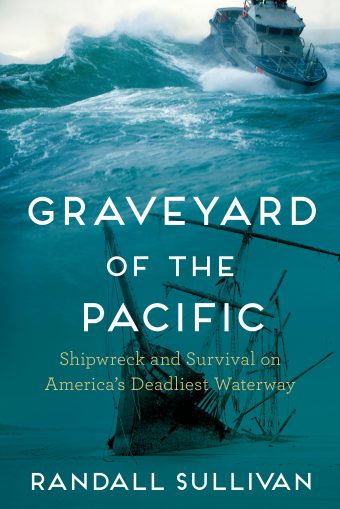Graveyard of the Pacific: Shipwreck and Survival on America’s Deadliest Waterway
- By Randall Sullivan
- Atlantic Monthly Press
- 272 pp.
- Reviewed by Lawrence De Maria
- July 14, 2023
A memoir disguised as an adventure tale.

I wish I could give an unequivocally good review of this book but I can’t — for the simple reason that it’s mistitled. That’s a pity, because Randall Sullivan can write well, as he has often proven in both magazines (Rolling Stone, Esquire, etc.) and in previous nonfiction books (including Dead Wrong, The Miracle Detective, and The Price of Experience).
And the prose in Graveyard of the Pacific: Shipwreck and Survival on America’s Deadliest Waterway is more than serviceable. Unfortunately, despite what its misleading subtitle suggests, the book is as much a memoir as it is a rip-roaring adventure saga. Not that I’m anti-memoir. Quite the contrary. I’ve read some great ones. But they were labeled as such, so I knew what I was getting.
(If this sounds like a pet peeve, I’m gratified to know I’m not alone. I just listened to a webinar in which an editor said that she is immediately turned off by a manuscript that promises one thing but delivers another.)
Basically, Sullivan and a friend, both 70-ish, wanted to test their mettle in a two-man kayak against the notorious Columbia River Bar, where the mighty Columbia River meets the even-mightier Pacific Ocean in Oregon. The battle between the land’s freshwater and the sea’s saltwater is often violent. Throw in intemperate weather and unforgiving tides, and the Columbia River Bar provides an environment not conducive to the survival of unwary seamen (as some 2,000 shipwrecks and untold drownings over the years can attest).
I read with interest what I consider the best parts of the book, those passages that detail the prehistoric creation of the Columbia River and that profile the ships and sailors who braved the swirling waves at its mouth. The courageous harbor pilots who tried to steer ships inland suffered many casualties themselves early on, usually when attempting to board a commercial vessel from their own small boats. (Typically, they zigged when swells caused the other crafts to zag.)
Modern technology — not to mention bigger boats — has only recently helped to keep the death toll down, as have jetties and the like. But it is still dangerous to sail the Bar. Many victims who have slipped beneath the waves, from experienced seamen to unlucky travelers, were never seen again. It’s no coincidence the U.S. Coast Guard trains its rescue crews there.
Which begs the question: Why would two ancient mariners such as Sullivan and his pal try to sail across the Bar even in benign weather? And in a kayak? Having once almost been cleaved in two by the mast of an overturned catamaran (despite my pleas that righting the vessel using a rope and a motorboat was not a good idea), I’m familiar with what can go wrong on the water. And I was on a calm lake in New Jersey.
The history of the area, especially before European settlers arrived, is fascinating and well told throughout the book. One takeaway: The fact that the Columbia River offered an “easy” route inland to the riches of the American continent is what first encouraged European sailors to challenge the Bar. As usual, the resultant white settlers soon evicted the Indigenous tribes that once had a rich culture in the Pacific Northwest.
It’s an old story, that, and one told well in this book. But given that Graveyard of the Pacific is not billed as a memoir, does the reader really also need to learn that Sullivan and his friend had abusive fathers and many marriages?
Those, too, are old stories — ones better told elsewhere.
Lawrence De Maria is the author of more than 30 thrillers and mysteries, all available on Amazon in print and e-book form. He writes a regular column, “The Write Stuff,” for the Independent.

